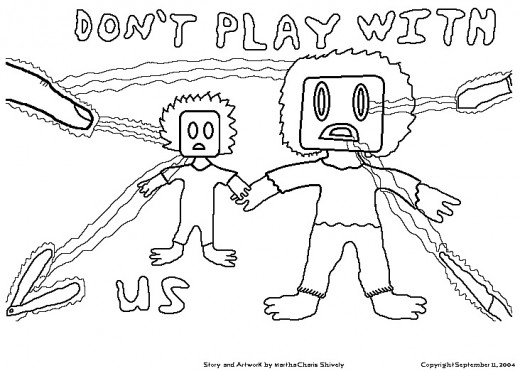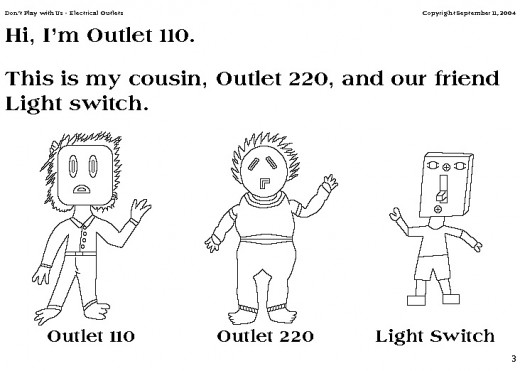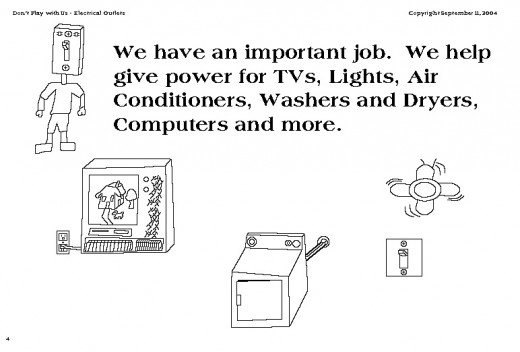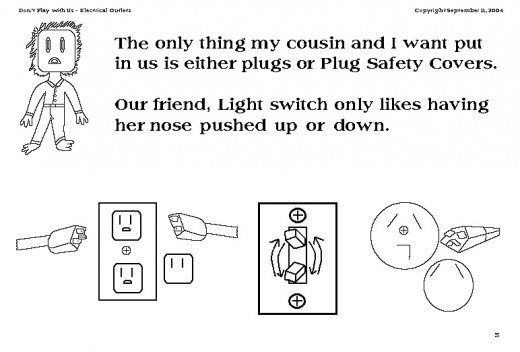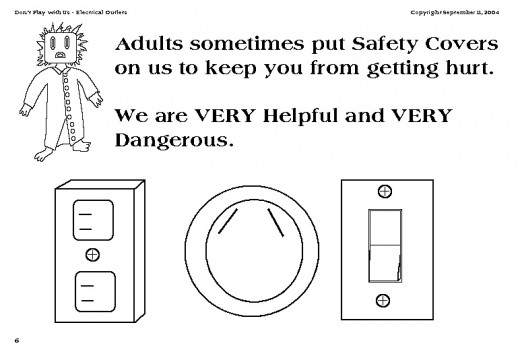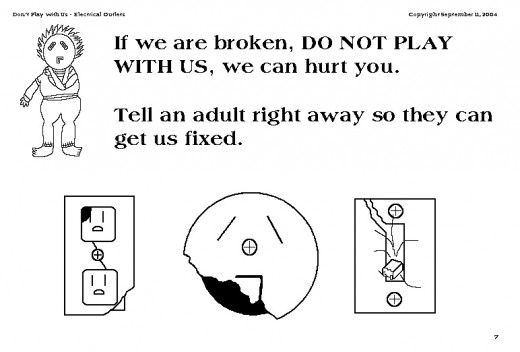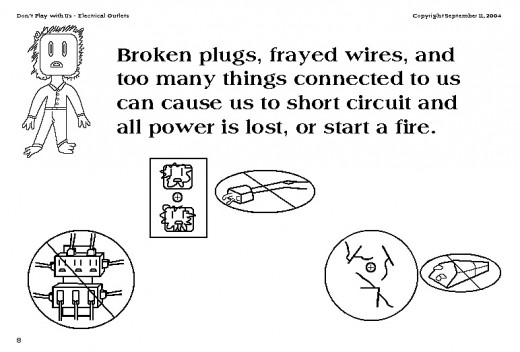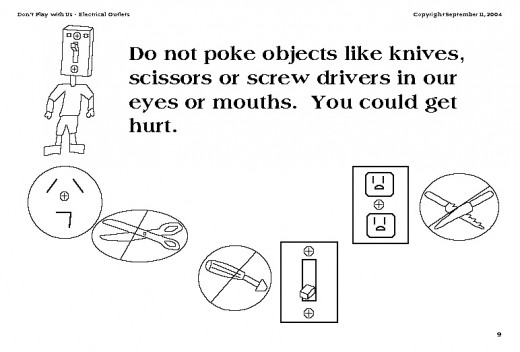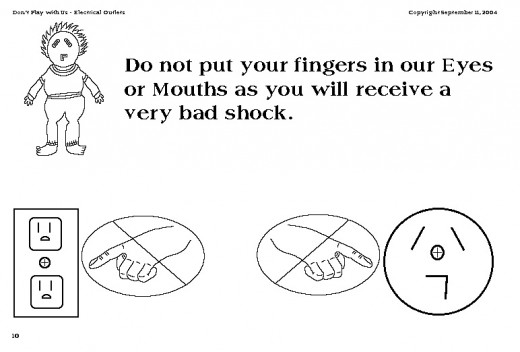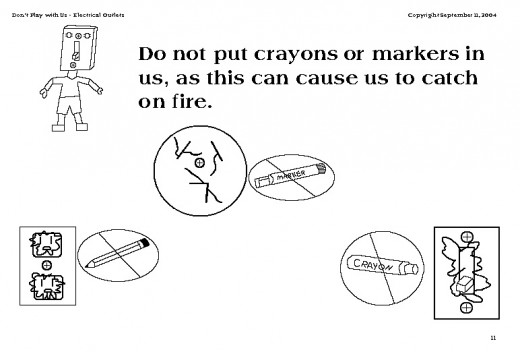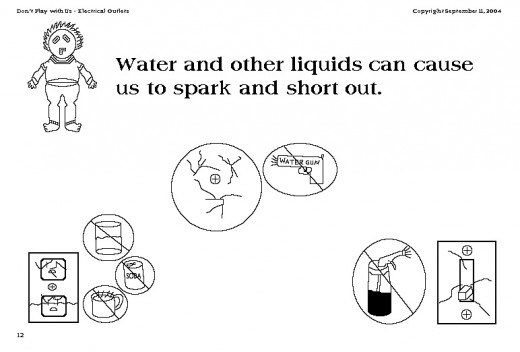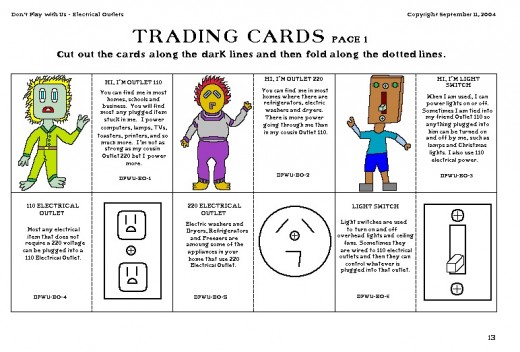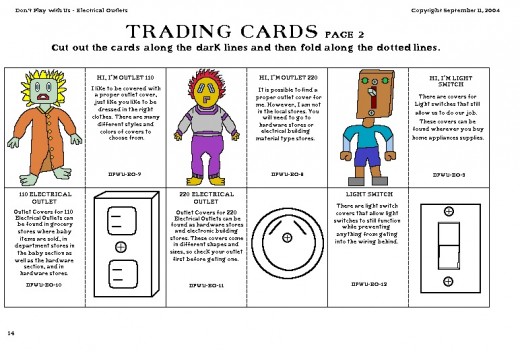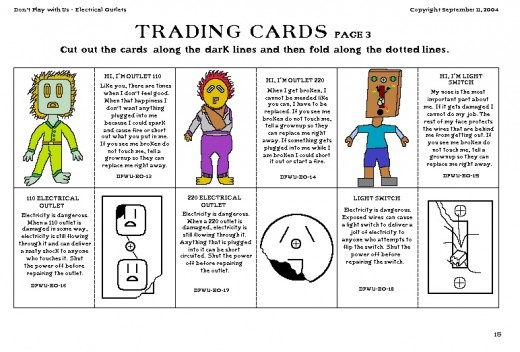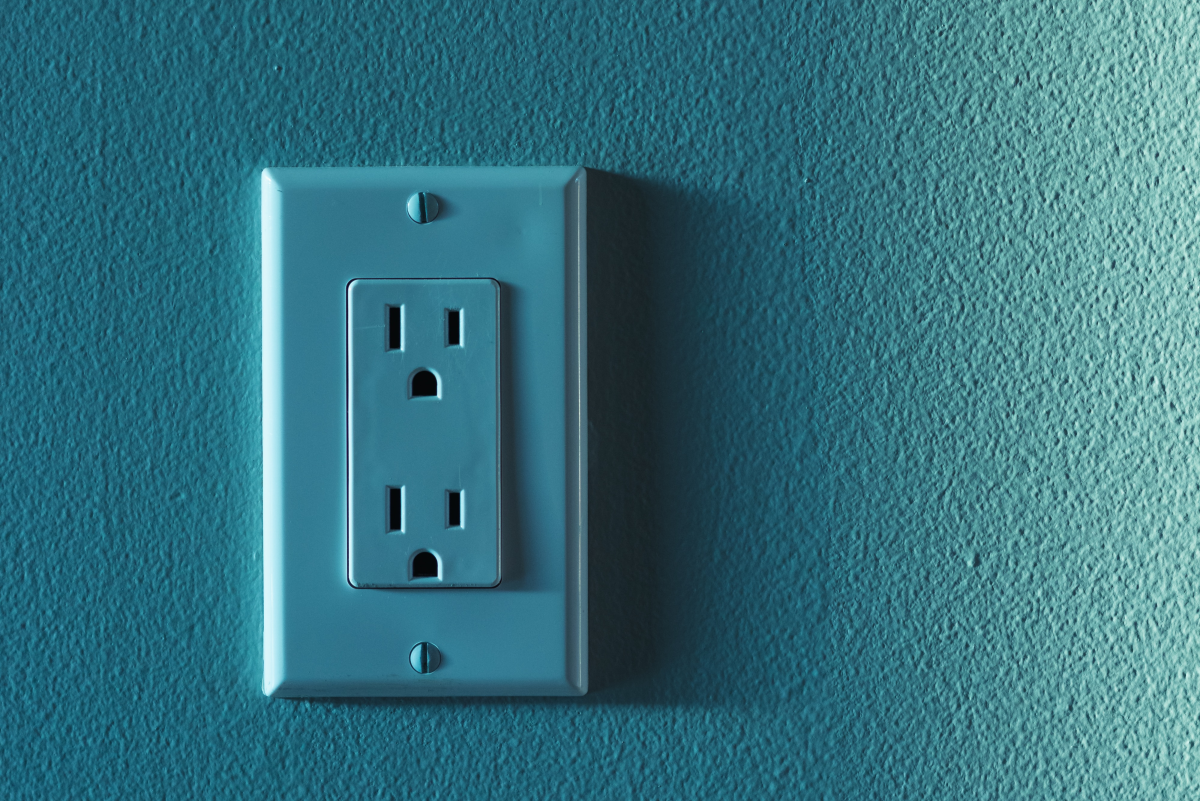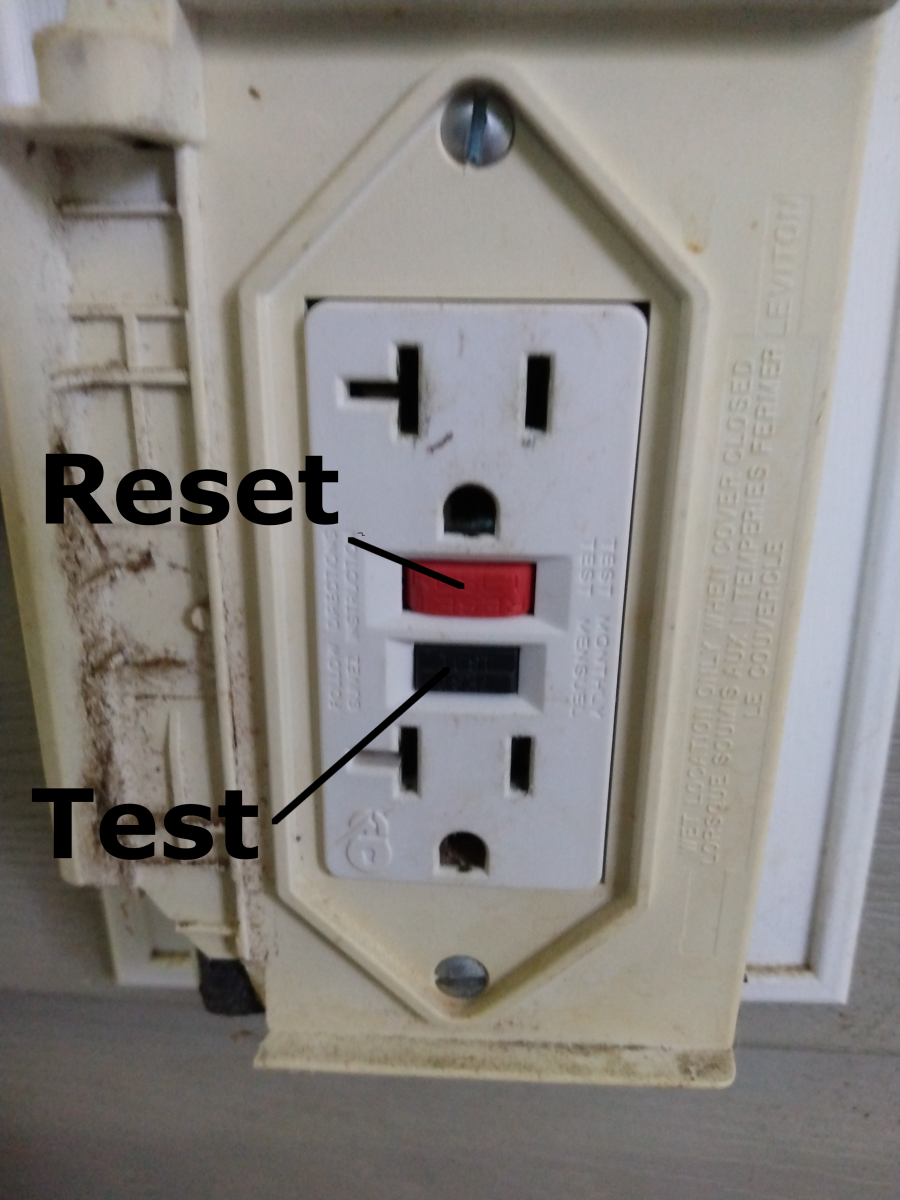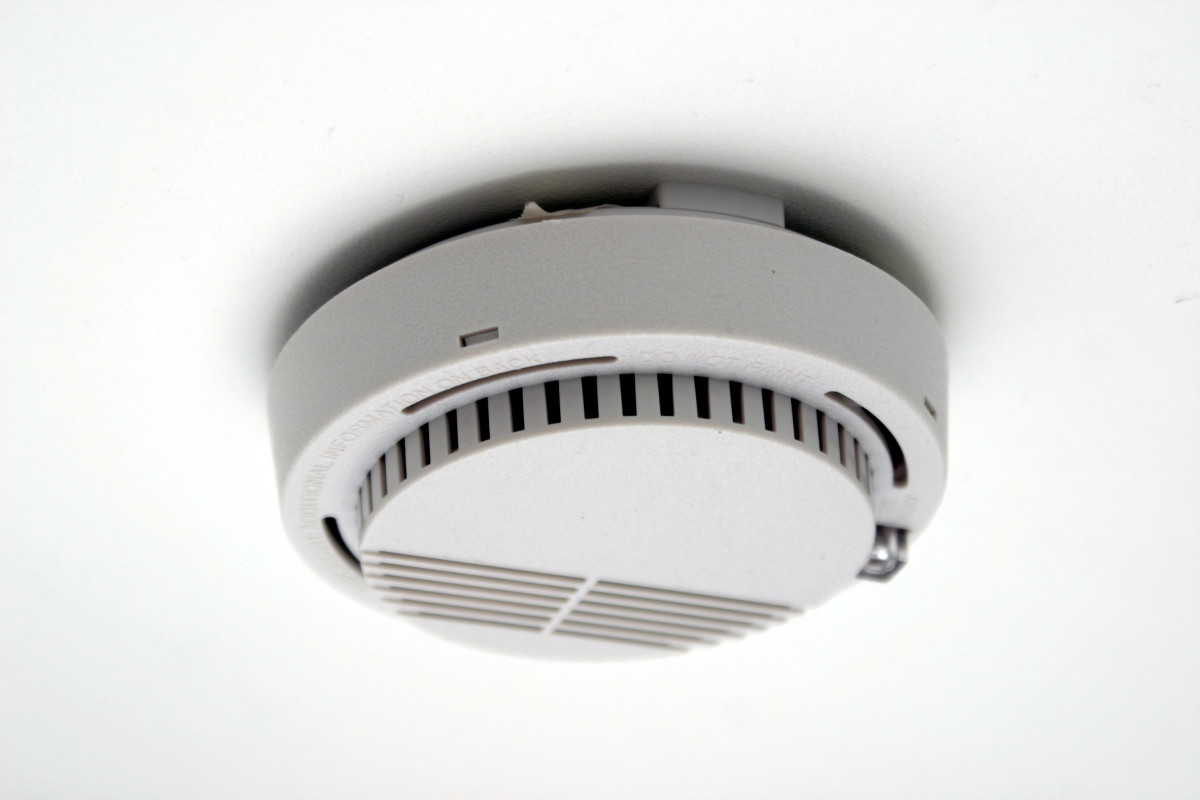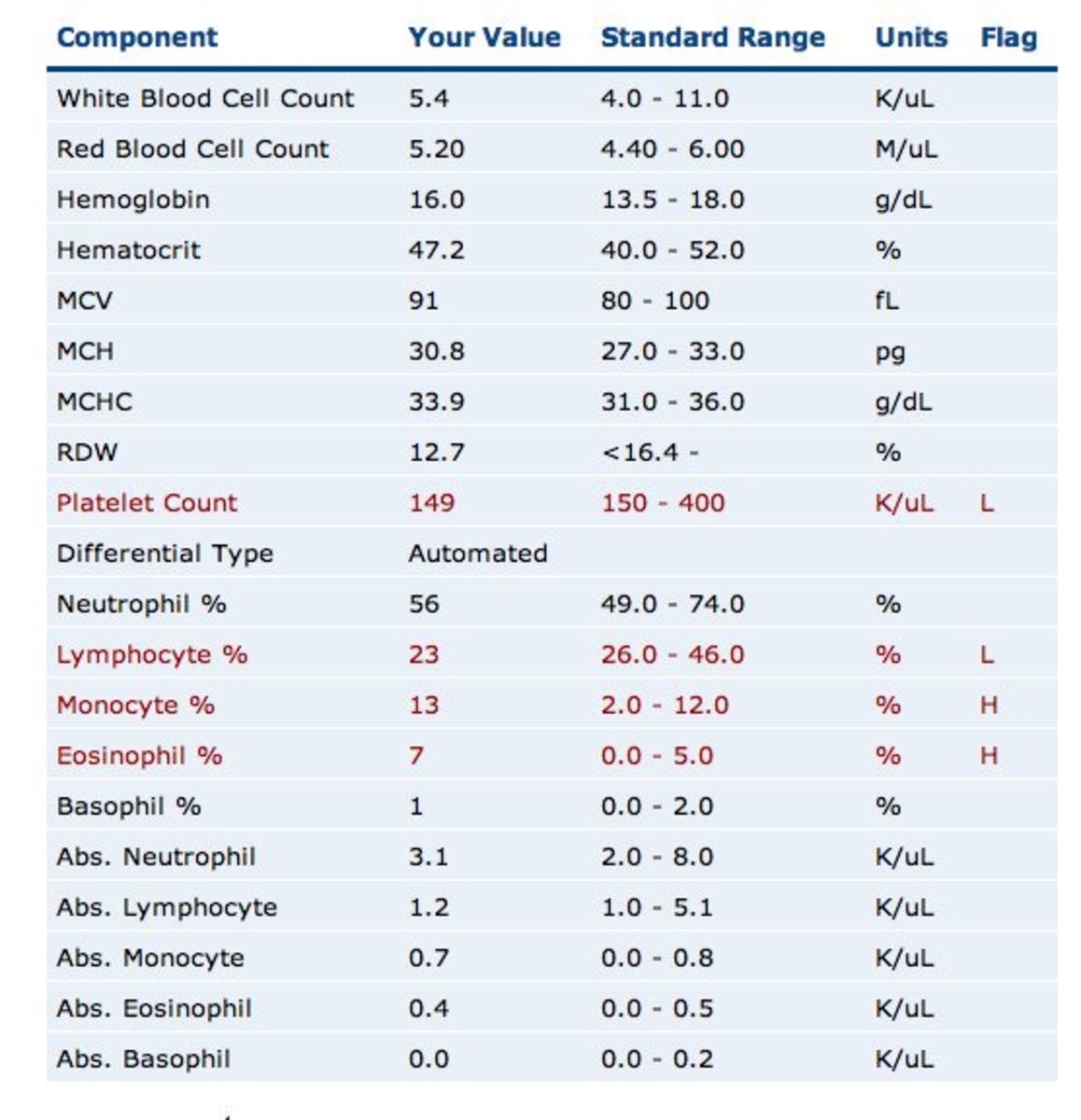Don't Play With Us-Electrical Outlets
Don't Play With Us-Electrical Outlet Coloring Book Pt1
Click thumbnail to view full-size



Electrical Outlets – A Child’s Fascination With, Can Be Dangerous
When my boys were younger, we put outlet covers over all our electrical outlets as we were instructed to do as foster parents. We used two different kinds of outlet covers. In the bedroom we used the kind that you can purchase in any store (even the grocery store) if you look in the baby section. These were the ones that look like buttons with little prongs sticking out that you can insert into the holes of the outlet. You need two per outlet. The other kind we purchased was one that covered the entire outlet and had a switch plate that had to be moved in order to plug something in. The “button” covers we had in the bedrooms, bathrooms and kitchen, while the “switch plate” covers we had in the rest of the house.
Do you use electrical outlet covers on all your outlets?
Did You Know?
"More than 30,000 non-fatal shock accidents occur each year. … Each day, nearly 7 children are treated in hospital emergency rooms for electrical shock or burn injuries caused by tampering with a wall outlet." (EFSi)
Don't Play With Us-Electrical Outlet Coloring Book Pt2
Click thumbnail to view full-size



Smarter Than They Look
My boys were (and still are) pretty smart for their age. They always figured out how to get around any obstacle that was put in their way of reaching their intended goal which was usually something in the kitchen. We kept the kitchen door locked for this reason, but there was an open window from the living room. The younger of the two figure out that if he climbed on the back of the couch he could fit through the window and climb down the sink and be in the kitchen. He also figured out how to get around the magnetic locks we had on all the drawers and cabinets. He would get what they wanted and then would push a chair up to the sink and would crawl back the way he came.
Did You Know?
"According to a 1997 Temple University Biokinetics Laboratory study of two plastic cap brands, 47 percent of four-year-olds tested could remove one brand of cap. More alarming, 100 percent of the 2- and 4-year-old children removed the second brand of cap —and, in many cases in less than 10 seconds." (NEMA)
Don't Play With Us-Electrical Outlet Coloring Book Pt3
Click thumbnail to view full-size



Shocking Discovery
One day, I went into the boys’ room to get them up from nap time and I found them asleep on the floor with a knife in between them. I took a quick scan of the room and I found they had taken the “button” outlet covers out of the outlets and tried to stick, not one, but three knives in one outlet and two knives in another outlet. Fortunately for me, and for them, their aim was not as good as their smarts. You may ask, why did I allow them to get the knives in the first place, and that would be a good question for a parent who constantly does not pay attention. I used the boys’ nap time to get laundry done, so I was out in the garage.
Has your child ever played with electrical outlets?
Did You Know?
"Each year, there is an estimated average of 60 electrocutions associated with consumer products. The three most common product categories associated with electrocutions are small appliance, power tool, and lighting equipment…. According to the U.S. Consumer Product Safety Commission, 70 percent of child-related electrical accidents occur at home, when adult supervision is present.” (EFSi)
Don't Play With Us-Electrical Outlet Coloring Book Pt4
Click thumbnail to view full-size



Inspiration
My oldest son was in special education Pre-K for speech delay. After seeing what I did in the room, I got an idea about a coloring book about safety in the home. I know, I know, there are different coloring books and story books about safety around the house. However, these books do not take into account the learning capacity of the child, just the age range. The series of books, which this is the first, is geared for those children who are learning disabled. It has been reviewed by my son’s teacher and she stated that even her more severe learning disabled students would be able to understand the message from the pictures.
Did You Know?
“NEMA conducted a study based on data from the U.S. Consumer Product Safety Commission (CPSC) and National Electronic Injury Surveillance Systems (NEISS). Findings indicated that, from 1991 to 2001, more than 24,000 children 10 years old or younger were treated in emergency rooms for incidents related to electrical receptacles. On average, this translates to about seven children every day.
It’s estimated that 89 percent of the children injured were less than six years old, but toddlers carried the greatest risk. With more than 12,000 victims between ages two and three, toddlers accounted for half of the children represented in the 10-year study. Data also showed boys to be at the highest risk, regardless of age.” (NEMA)
Home Safety Survey
There are things that can be done to reduce the chances of electrical shocks in the home. Start by taking a look around the house at all the electrical outlets. Determine how many are at eye level of a toddler or young child. Purchase some taper resistant outlet covers and replace the existing covers. For those outlets that are in use, purchase outlet covers which also protects the plugs of the items using the outlet. For a list of other ways to make the home safe, consult the state child care provider licensing board, or home owners insurance.
Did You Know?
“The Electrical Outlet Safety for Iowa Child Care Providers lists some ways to conduct a preventative walkthrough of one’s home or business.
Conduct a child’s eye-level assessment of all young children occupied areas, including play areas, diaper-changing stations, near cribs, bathrooms, outdoor play areas, etc.
Identify and determine condition of electrical outlets, plugs, and cords in use and replace any that are broken, worn or damaged. The U.S. Consumer Product Safety Commission recommends assessing the condition of electrical items every six months.“ (Electrical Outlet Safety for Iowa Child Care Providers)
Conclusion
It is my sincere hope that when I complete the series, I will be able to make them available to all Pre-K classes and families who have children with learning disabilities.
References
Electrical Safety Foundation International (ESFi) - http://www.esfi.org/index.cfm/page/Injury-and-Fatality-Statistics/pid/12015
NEMA - http://www.childoutletsafety.org/files/NEMA.PDF
Electrical Outlet Safety for Iowa Child Care Providers - http://www.idph.state.ia.us/hcci/common/pdf/electrical_outlet_safety.pdf

